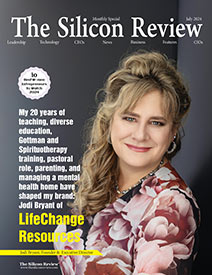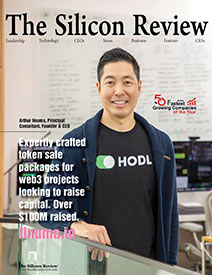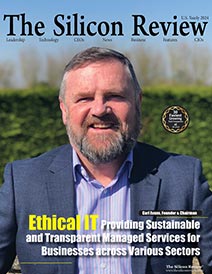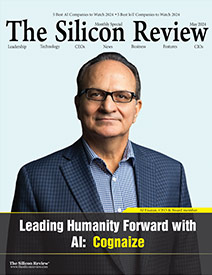>>
Technology>>
Storage>>
Challenges and Solutions for M...Challenges and Solutions for Media and Entertainment Customers in a Remote Work World – by Eric Toczek, Director of Sales Engineering at Storage Made Easy.
The Silicon Review
22 June, 2021
I work for Storage Made Easy, we're a software company with a mission to make it easier for users to access their data and media assets on any storage from any location - including file and object/cloud storage, and users in the office, remote offices or even from their own home offices. We have many Media and Entertainment customers we've helped modernize their media workflows and provide secure remote access to assets.
Most Media and Entertainment customers we've talked with are all facing the same obstacles as they look to continue to grow and leverage the latest technologies available. That can be things like active archive storage from their primary NAS devices to on premises object storage or even off to cloud storage. Now that they've got an active archive of old assets, how do they allow their users to quickly search and discover the assets and move them to the primary tier in a quick and easy fashion. And finally, sharing of media assets, both sending and receiving, with third party vendors and customers.
Moving to an Active Archive
While tape may never really go away, many organizations are moving to cloud and object storage for their long term retention of media assets. The cost has come down to where it's economically feasible to use these alternate storage devices instead of the traditional tape methods. But cost is only one key factor, the other is quick and easy retrieval. M&E companies aren't keeping around the old assets for any compliance reason, but rather because they may want or need that data - a football player is retiring so let's find his best highlights, a past guest on a talk show is coming back and we want to show a clip from the last time they were on.
When M&E companies have their assets now on those Cloud and Object storage platforms, the ability to browse, and retrieve those files becomes a feature of their overall data strategy, not just a cost savings method. But companies will want some flexibility and not become locked in to any one specific method for accessing data. They will want to be able to have a cold tier on an on-premises object platform, and be able to tier that off to a frozen tier in one of the public clouds. Or possibly multiple public clouds, moving data as required between them.
That flexibly and single pane of glass view across all the systems is one of the key features of Storage Made Easy's Enterprise File Fabric. As M&E customers look to have data in multiple locations, the File Fabric allows them to present a user friendly interface to that storage regardless of where it resides. But that single pane of glass is just the start.
End User Search/Discovery/Retrieval from that Active Archive
For M&E customers, getting data into that Active Archive is just the start. The next step is how do they empower their users to better access that data. Gone are the days of companies being able to just rely on IT tickets and restore requests for data. M&E organizations are looking to figure out ways to empower their end users to find the assets they’re looking for, to validate that they are the right asset and to move those assets to their active tier to then edit and interact with.
In an ideal world, an end user - not an IT staff member, would be able to browse out through that Active Archive. They would be able to do a fast, indexed search of file names, metadata, tags and even full text search of text and document files, preview the asset, and then simply copy the asset from that archive to primary storage. Since these are often large assets, with 4k video files and even 8k video files starting to become the norm, these copy operations need to be fast enough that users don't just decide to leave all their assets on the fast storage so they don't have to wait for retrieval.
We've got many M&E customers leveraging the File Fabric to do just that. With Full text, file name and metadata search the media operations teams are able to find an asset anywhere in the storage their company has data. Now they've found what they believe to be the correct asset they browse out and maybe can review additional files in that same location (script information, show notes, etc). But they may want to then also preview that asset to make sure it's the clip they were looking for. The File Fabric allows the transcoding of lower-res proxy files that can live side by side the original, and right from within a web browser the operations team can play back that proxy, scrub through and validate it's the it’s the right thing. Now they want to move it back to their primary storage? Easy enough, just drag and drop from one folder to another and the File Fabric worries about the rest. That will include copying it server side, not from the client's machine, and as a background task. In addition, using File Fabric's M-Stream technology, those large assets are transferred in an accelerated fashion between the tiers, moving the data in parallel streams to achieve the highest possible copy and moves between those storage pools.
Remote Workforce
While using remote workers is nothing new to M&E customers, the trend has sharply increased with the pandemic and we probably won't see that trend stop. Both employees now working from home offices, we also see M&E companies engaging with third-party vendors or contractors for parts of the media operation workflow. In the past, many M&E customers would turn to some of the Cloud Storage SaaS companies to do their sharing and collaboration with those remote workers.
The problem many M&E customers saw is now their duplicating their data and having to deal with whole new lifecycle workflow for the data in these sharing platforms. Copy the assets up to the SaaS platform's storage to be shared out, edits are done locally how do you make sure you update in that platform, your remote users are making changes, where's the source of truth of that data? What M&E customers really want is to be able to share out their storage directly, in a secured and controlled manner.
We have many M&E customers using the File Fabric for just that. Both for named - logged in users, Guests Accounts through federated login, or even just the creation of shared links of files and folders on their storage devices. The Enterprise File Fabric allows for users across the globe, just via a web browser to see all the of assets they have been given permissions too, and not a copy of those assets - but the actual asset as it sits on their NAS/Object/Cloud storage. What's more, the File Fabric M-Stream technology is not just for server to server copies, but also allowing that same parallel, and accelerated upload of data through the browser, no plugins required. In an upcoming release, we will be introducing a plugin based download via the accelerated M-Stream technology.
These are just a few of the many obstacles M&E companies are facing as they look to modernize their technology stack, and provide more user-friendly, self-service style offerings. They say that data is the new oil, and for M&E companies their assets very much fall into that category. Through tools like the Enterprise File Fabric, many M&E customers have been able to move into these new technologies and approaches to data management.









